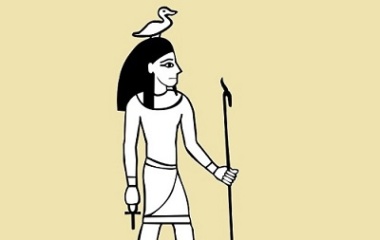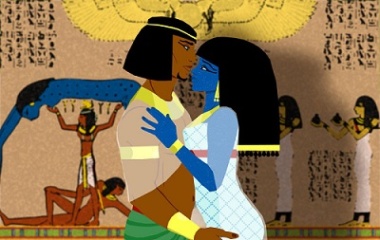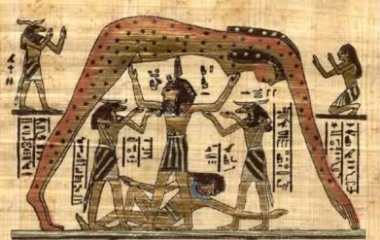Who Is Geb?
Geb was popularly known as the god of the earth to Ancient Egyptians. Although his name translates to “weak one” or “lame one”, Geb is considered one of the mighty kings of the Egyptian gods. He protected the sun god while a passenger on the great sun ship, and was also tasked with guiding the deceased to the afterlife and providing provisions – meat and drink – to traveling souls. Geb’s name was often invoked to heal sick people, especially those stricken with illnesses created by natural elements, such as scorpion stings and colds. Geb’s roles in Egyptian society were limitless as one of the most powerful gods; his similarly powerful myth lives on in today’s society.
The legendary Geb is often thought as ambivalent to his human worshippers, creating earthquakes with his laughter and droughts without reason. As the god of the earth, he made the massive, inhospitable deserts isolating Egypt from the rest of the ancient world. But Geb could be a kind god too. After all, he created the lush, fertile lands surrounding the Nile River. Under Geb’s influence, believers would be blessed with bountiful harvests and enough crops to fatten their livestock.
Origin
Although the exact origins of the Geb myth are illusive, many scholars agree that the god’s religious fervor was centralized to the city of Heliopolis. Located near Egypt’s modern day capital, Cairo, Heliopolis originated, adopted, and spread the Ancient Egyptian creation myth that all later narratives evolved from. Condensed, the creation myth describes the inception of existence via a hermaphroditic deity, Atum. Atum is both the original king and creator of the gods.
Legends and Stories
The Egyptian god of the earth is affiliated with many legends involving ancient society. In the Heliopolis creation myth, Geb is created by his parents and then falls in love with his sister, Nut, goddess of the sky. Shu, Geb’s father and god of the air, is angered by this and physically separates the two by placing himself between them. This legend explains why the air (Shu) separates earth (Geb) and sky (Nut).
Another legend surrounding the Egyptian god Geb involves the conflict between two of his offspring: Set and Horus. The brothers fought to take control of Egypt, and when the infighting became troublesome to Geb, he appeased both sons by giving power to each: Horus was given Lower Egypt and Set maintained Upper Egypt. The tale of Geb’s fair judgment inspired many Egyptians and influenced modern day mediation techniques.
Family
Geb was born after the joining of two powerful deities. Unlike most gods, however, his parents were both created by the ultimate Egyptian creator god, Atum. Atum appeared as a self-generating deity bringing light to the chaos of Nun, the endless, murky waters of nothingness. Atum embodied both masculinity and femininity, and thus, could create life himself. After establishing light, Atum made Shu, the god of the air, and Tefnut, an obscure goddess with command over moisture.
Shu and Tefnut then gave birth to two children of their own, Geb and Nut. The god of earth and goddess of the sky fell in love with each other and produced equally powerful deities. Their children include Osiris – god of the dead; Isis – goddess of sovereignty; Seth – god of brute force; Nephthys – a funerary goddess. In some legends, Geb is also accredited to fathering Horus, though cults of Ancient Egyptian mythology differ on parentage.
The mighty Egyptian god of earth, along with the members of his immediate family, make up the Ennead, translated as “group of nine”. These nine all-powerful deities represent the animating forces that helped create both the natural and political order of Ancient Egypt.
Appearance
The Egyptian god of the earth is typically shown as a dark or green-skinned man with leaves on his skin and wearing a crown, either of the North or South. His skin tone likely represents the fertile soil of the Nile and vegetation growth, the colors of life for the ancients. In addition, Geb also appears with the Atef crown – a white-feathered crown associated with Osiris – or a goose, his chosen sacred animal. Sometimes his head is depicted as that of a snake to represent his affiliation with the creatures and their symbolization of earth.
A common image of Geb shows the god of earth splayed underneath his wife – Nut, the goddess of the sky – and his father – Shu, god of the air. Geb is seen reclining on one elbow while an arm rests on an upward, bent knee. The image represents the earth’s intimate relationship with both the sky and air. It also depicts Geb’s limbs as the valleys and hills of the land, which were often referred to as “The House of Geb” by Ancient Egyptians.
The oldest physical representation of Geb can be dated back to the Third Dynasty of Ancient Egypt (2670 BCE), during King Djoser’s rule. A fragmented relief sculpture found in Heliopolis depicts the Egyptian god as a mysterious anthropomorphic bearded entity. Later depictions ascribe Geb to the likeness of a ram, bull, or crocodile. The latter can be found in a vignette of the Book of the Dead, a collection of ancient spells ensuring the soul of the deceased safe passage to the afterlife.
Symbology
Geb’s main symbol was the goose. Legends say that the god was able to transform into the fowl, lending Geb the name “The Great Cackler”. The goose itself symbolizes the lush life found in parts of the Fertile Crescent. Some chief Egyptologists have even suggested that Geb’s association with the goose was due in part to his relationship with the divine creator goose. The controversial myth states the creator goose laid an egg from which the world, sun and earth sprouted.
Geb was also heavily associated with snakes. Reliefs and other Ancient Egyptian art depict Geb as part-man, part-snake to emphasize this relationship. One of the snake’s literal translations was “son of the earth”. Within the Book of the Dead, Geb was described as the father of snake creature Nehebkau.
Gods Similar to Geb
Most polytheistic ancient religions have deities assigned to watch over, embody, or symbolize the earth. Similarly to the popular Western idea of “Mother Earth”, Geb embodied earth and was responsible for geography, earthquakes, droughts, soil fertility, and anything else related to the earth’s composition. These responsibilities have often been broken up and split between several nature deities throughout later cults, religions, and mythologies. For instance, in Celtic mythology, Viridios was the god of vegetation, while Nantosuelta was the Gaulish goddess of the earth.
Other deities similar to Geb include Hinduism’s Dhara – god of the earth elemental; Emesh – the Sumerian god of vegetation and woods; Houtu – ancient Chinese deity of deep earth and soil; and Veles – the major Slavic god of earth, waters, and forests.
Geb is also sometimes identified with the Greek god Kronos.










